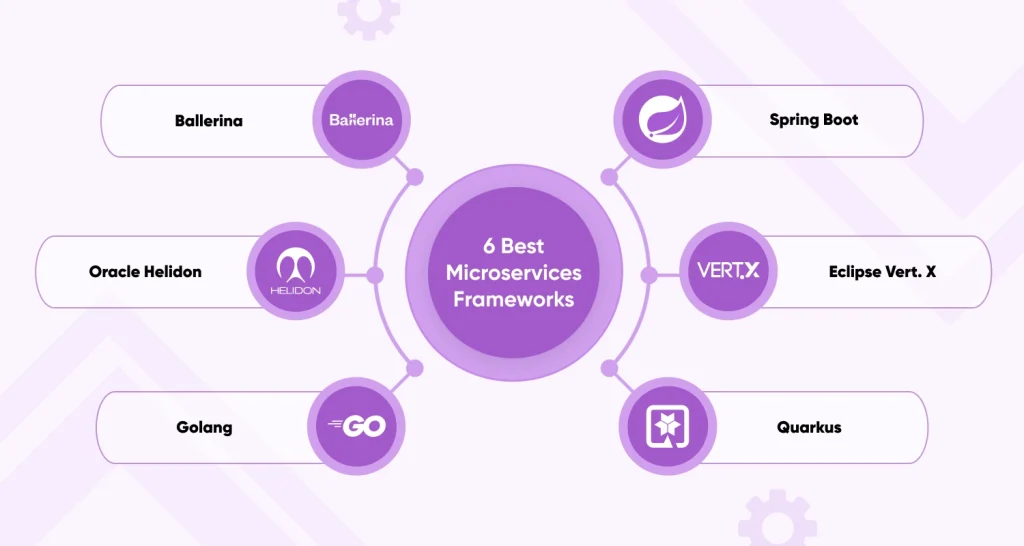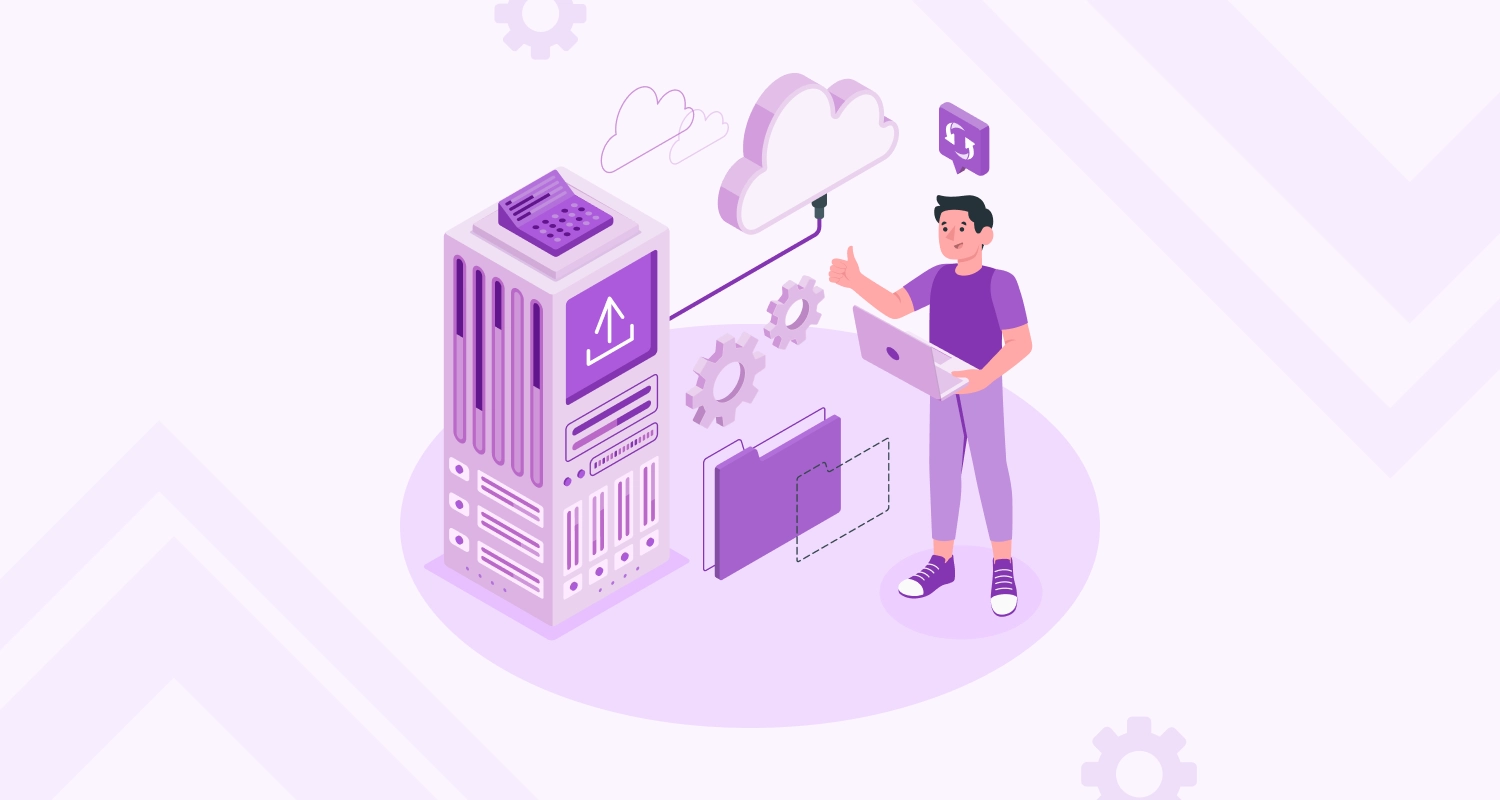Are you confused about what to use for developing applications with microservices frameworks? Dive into the latest frameworks and their features. Once you decide on the framework, hire dedicated developers who can understand your requirements and develop scalable applications for your business.
Microservices architecture is a method where monolithic single applications are divided into smaller apps. Various programming languages and frameworks are available to create applications. However, the main goal is to create independent models.
6 Best Microservices Frameworks to Create Scalable Applications

To take on the task, a software development company must be able to select a framework with interactive tools that are needed to create a robust and powerful application.
Furthermore, these frameworks influence the cost, development time, complex features, and maintenance. Here is a list of the top microservices frameworks that explain the process and cover the business capabilities and advantages of microservices frameworks that work well for your project.
1. Spring Boot
The most popular and modern Java microservices framework for creating microservices is Spring Boot. It currently has 59.2k ratings on GitHub and is becoming more popular due to the lack of any serious rivals in the area.
With the help of Spring Cloud and Spring Boot, developers may create a self-contained software architecture that gives their code robustness and flexibility. Beginning with this microservices framework, developers can use Spring Initializer to quickly launch their apps before packaging them as JAR files. Additionally, the embedded server model’s ability to support quick development gives it an advantage in terms of the time it takes to market contemporary applications. When there are numerous applications being used, Spring Boot isn’t the ideal framework choice.
Benefits:
- Allows the use of Spring MVC for the creation of reactive microservices applications with rest API.
- It is straightforward to integrate with well-known frameworks because of its Inversion of Control.
- Complex application architecture’s time to market has sped up.
- Using Cloud Foundry to easily link numerous backend services while horizontally scaling.
- Complex application architecture’s time to market has sped up.
2. Eclipse Vert. X
Eclipse Vert. X should be your first option if you’re searching for an event-driven microservices framework to build apps. It is a multilingual framework that supports Ceylon, Java, JavaScript, Groovy, Kotlin, and Java. The framework is a great option for sophisticated applications with a service-oriented architecture because it operates on a Java Virtual Machine.
Vert. X, created by the Eclipse Foundation, includes resource-efficient features that can concurrently process numerous requests, in contrast to conventional stacks and frameworks based on blocking I/O. Tasks can be completed in a restricted environment, particularly in containers. Vert. X is most recognized as a microservice framework because of its adaptability in composability and integrated features, which make it more of a highly scalable toolkit than a framework.
Web APIs, databases, event streams, messaging, the cloud, security features, registries, and a number of other components are all included in the Vert. X ecosystem, which makes it simple to build sophisticated modern apps. The benefit of adding new features from a ready-made repository is another benefit of being an open-source framework for developers.
Benefits:
- With a 650kb foundation, it is limited in size.
- It is easy to carry out medical checks using Vert. X web or an event bus.
- Using Vert.XUnit, asynchronous unit tests are run.
- According to the program code provided by Google, it supports gPRC.
3. Quarkus
Quarkus’s microservices technology has been endorsed by Kubernetes enthusiasts! A Kubernetes-native JS framework made exclusively for OpenJDK HotSpot and GraevalVM is Red Hat’s Quarkus. The framework offers a dynamic and impulsive programming methodology to address the architectural challenges of microservices.
Kubernetes is intended to maximize quick developer setup and minimal memory usage. Due to their quick launch times, microservices and Kubernetes can scale automatically.
Microservices, which separately start many containers, can maximize container capacity thanks to low memory use. However, inexperienced programmers are hesitant to utilize it due to the complex GraalVM setup and OS-specific binary verification.
The Quarkus development paradigm’s ability to seamlessly interact with serverless architectural systems, reactive programs, and HTTP microservices is one of its benefits. The efficiency of developers is much improved by their straightforward traits and easily understandable methodology, which focuses on the business aspect of the complete program. Additionally, consistent configurations, live programming, DEV UI, and test automation enhance the dedicated development team of microservice experiences.
Benefits:
- Has many different technologies, frameworks, and APIs, making it simple to understand and utilize.
- It’s a generational framework that improves JVM coding and Native script to increase application performance.
- In comparison to other container-first frameworks, it claims faster load times.
- Inadequate RSS memory and high memory usage.
4. Golang
The Go programming language has grown in popularity among developers who specialize in microservices as a result of Google’s assistance and services. One can quickly develop a distributed architecture for any application by integrating GoKit and GoMicro, which are specifically made for building microservices on Golang. It’s a top-notch microservices framework for developing REST and gRPC (Google Remote Procedure Call) protocols that enable smooth communication between various services.
Benefits:
- A pluggable toolkit that developers using the Go programming language can use to create apps.
- prepared, pre-made templates for a quick start.
- A web-based query and service exploration dashboard.
- Microservice architecture that supports powerful and complex programs is easily testable.
5. Oracle Helidon
Helidon is gradually dominating the microservices industry in terms of popularity thanks to its quick and lightweight application development capabilities. It is a free, open-source collection of cloud-native Java libraries that can function on the quick web and are driven by Netty. This library uses the Helidon Reactive WebServer, a functional programming paradigm that offers a user-friendly framework for microservices.
Helidon is a cloud-native declarative programming model with a number of features that make it stand out from the crowd. For instance, it fully supports the Eclipse MicroProfile, CDI, GraphQL, CORS, and gPRC for databases. Additionally, it uses 92 MB of disc space and has the smallest memory footprint, with a minimum of 70 MB when using Helidon and GraalVM Native.
Applications run quickly and responsively because of Oracle Helidon’s support for some of the most robust and widely used APIs, including JAX-RS, CDI, and JSON-P/B. There is also no added overhead or bloat for an application, which developers may experience when utilizing other frameworks because Netty is a collection of Java libraries operating on a Netty core. Integration with Prometheus, Jaeger/Zipkin, and Kubernetes is supported by health checks and metric observability tools. Additionally, you can also build your Helidon programs into tiny native executable files, as a jlink image, or as a standard JAR application using GaalVM Native Image Support.
Benefits:
- A minimal starting time exists, spanning the range of 0.09 to 2.03 seconds.
- Consists of a whole cloud environment with all essential and popular technologies.
- Includes the Helidon SE and Helidon MP versions for various programming needs.
6. Ballerina
Ballerina is a distributed programming language for creating distributed systems, moving away from conventional microservices frameworks. It is a cloud-native, open-source programming language. Additionally, because it is a structural style language, developers have the freedom to describe the program’s service interfaces and implement static typing within it.
Ballerina enables developers to create a decoupled system from the start because it is data-oriented, graphical, and concurrent in nature. It is intended to build networking systems and applications that can deliver networking services.
Ballerina is a particular system with clear criteria, but it nevertheless works into the modern application development lifecycle. It is also capable of seamlessly integrating CI/CD tools, observing and monitoring tools, and cloud orchestration systems in addition to its built-in capabilities for the perfect creation of applications.
Even as they are writing the codes for future seamless deployment services, it features an intuitive feature that warns developers about potential security risks, network issues, and communication breakdowns.
Benefits:
- Modules and asynchronous interaction language that works well with sequence diagrams were created in order to enable the bidirectional translation of the Ballerina source code between written and visual presentations.
- A type paradigm for dynamic architecture that allows for looser coupling than normal highly typed programs.
- Include cloud orchestration systems like Kubernetes, observability solutions like Prometheus, Zipkin, and Honeycomb, and continuous integration and delivery technologies like Jenkins, Travis, and Codefresh in your project.

Choose the Best Microservices Frameworks
The number of scalable microservices frameworks will continue to grow and change over time. Although these frameworks may share some traits and standards, the proper apps should be created around business capabilities, which can only be done with the help of a suitable framework. Considerable factors include the large range of programming languages available, key functionality incorporated into particular apps, database support, simplicity of integration, and much more.
Before selecting a micro frontend framework for your application, consider the following list of considerations.
- Do you have built-in support for observable application metrics, health checks, and analytics in your microservice framework?
- Does your framework support the requisite technology and standard APIs for the building of applications?
- Does your framework permit the incorporation of automation technologies for faster and more efficient development?
- Does your distributed system independent deployment framework for microservices support it?
- Does your framework allow for individual customization and does it contain decentralized components?
- Does your microservice framework allow for the integration of CI/CD technologies to enable DevOps? Does it support continuous integration, deployment, and continuous delivery (CI/CD)?
- Can the chosen framework adapt to changing needs or business models?
- When a developer is writing code, can the microservice framework perform unit tests?
- Does the framework offer support for the database you consider to be essential for your application?
You may like this: Best Steps to Creating a Web Application
Conclusion
Modern applications are more dependent on microservices as efficiency, productivity, delivery, and speed requirements increase. Choosing the right framework may seem difficult because it is expensive to experiment with in different situations. Claiming that the chosen framework would produce the desired results takes an excellent eye for detail.
The cloud development specialists at CMARIX are very competent at bringing any organization to new heights and are familiar with the complexities of microservices. Consult with us right now about putting a new microservices framework in place for your startup company.
Frequently Asked Questions
A software architecture known as a microservice framework enables programmers to create applications as a group of tiny, independent services. Application development can be flexible and modular thanks to the distinct deployment and scaling options available for each service.
Spring Boot is an illustration of a microservices framework. A complete set of tools and libraries are provided by Spring Boot for the development of Java microservices. It is well-liked by developers because it provides capabilities like dependency injection, configuration management, and streamlined deployment.
In the context of app development, the term “microservices” refers to an architectural strategy in which apps are broken up into smaller, loosely linked services that may be created, launched, and scaled independently. This strategy encourages modularity, flexibility, and simpler maintenance because each microservice concentrates on a particular application functionality.
